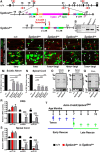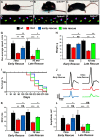Reorganization of Destabilized Nodes of Ranvier in β IV Spectrin Mutants Uncovers Critical Timelines for Nodal Restoration and Prevention of Motor Paresis
- PMID: 29907663
- PMCID: PMC6041796
- DOI: 10.1523/JNEUROSCI.0515-18.2018
Reorganization of Destabilized Nodes of Ranvier in β IV Spectrin Mutants Uncovers Critical Timelines for Nodal Restoration and Prevention of Motor Paresis
Abstract
Disorganization of nodes of Ranvier is associated with motor and sensory dysfunctions. Mechanisms that allow nodal recovery during pathological processes remain poorly understood. A highly enriched nodal cytoskeletal protein βIV spectrin anchors and stabilizes the nodal complex to actin cytoskeleton. Loss of murine βIV spectrin allows the initial nodal organization, but causes gradual nodal destabilization. Mutations in human βIV spectrin cause auditory neuropathy and impairment in motor coordination. Similar phenotypes are caused by nodal disruption due to demyelination. Here we report on the precise timelines of nodal disorganization and reorganization by following disassembly and reassembly of key nodal proteins in βIV spectrin mice of both sexes before and after βIV spectrin re-expression at specifically chosen developmental time points. We show that the timeline of nodal restoration has different outcomes in the PNS and CNS with respect to nodal reassembly and functional restoration. In the PNS, restoration of nodes occurs within 1 month regardless of the time of βIV spectrin re-expression. In contrast, the CNS nodal reorganization and functional restoration occurs within a critical time window; after that, nodal reorganization diminishes, leading to less efficient motor recovery. We demonstrate that timely restoration of nodes can improve both the functional properties and the ultrastructure of myelinated fibers affected by long-term nodal disorganization. Our studies, which indicate a critical timeline for nodal restoration together with overall motor performance and prolonged life span, further support the idea that nodal restoration is more beneficial if initiated before any axonal damage, which is critically relevant to demyelinating disorders.SIGNIFICANCE STATEMENT Nodes of Ranvier are integral to efficient and rapid signal transmission along myelinated fibers. Various demyelinating disorders are characterized by destabilization of the nodal molecular complex, accompanied by severe reduction in nerve conduction and the onset of motor and sensory dysfunctions. This study is the first to report in vivo reassembly of destabilized nodes with sequential improvement in overall motor performance. Our study reveals that nodal restoration is achievable before any axonal damage, and that long-term nodal destabilization causes irreversible axonal structural changes that prevent functional restoration. Our studies provide significant insights into timely restoration of nodal domains as a potential therapeutic approach in treatment of demyelinating disorders.
Keywords: axonal health; motor coordination; myelination; nerve conduction; nodal restoration; nodes of Ranvier.
Copyright © 2018 the authors 0270-6474/18/386267-16$15.00/0.
Figures







Comment in
-
Nodal Dynamics after In Vivo Rescue of βIV Spectrin Expression.J Neurosci. 2019 Jan 2;39(1):15-17. doi: 10.1523/JNEUROSCI.2149-18.2018. J Neurosci. 2019. PMID: 30602540 Free PMC article. No abstract available.
Similar articles
-
Early and Late Loss of the Cytoskeletal Scaffolding Protein, Ankyrin G Reveals Its Role in Maturation and Maintenance of Nodes of Ranvier in Myelinated Axons.J Neurosci. 2017 Mar 8;37(10):2524-2538. doi: 10.1523/JNEUROSCI.2661-16.2017. Epub 2017 Feb 1. J Neurosci. 2017. PMID: 28148727 Free PMC article.
-
An αII Spectrin-Based Cytoskeleton Protects Large-Diameter Myelinated Axons from Degeneration.J Neurosci. 2017 Nov 22;37(47):11323-11334. doi: 10.1523/JNEUROSCI.2113-17.2017. Epub 2017 Oct 16. J Neurosci. 2017. PMID: 29038243 Free PMC article.
-
Schwannomin-interacting Protein 1 Isoform IQCJ-SCHIP1 Is a Multipartner Ankyrin- and Spectrin-binding Protein Involved in the Organization of Nodes of Ranvier.J Biol Chem. 2017 Feb 10;292(6):2441-2456. doi: 10.1074/jbc.M116.758029. Epub 2016 Dec 15. J Biol Chem. 2017. PMID: 27979964 Free PMC article.
-
Nodes of Ranvier during development and repair in the CNS.Nat Rev Neurol. 2020 Aug;16(8):426-439. doi: 10.1038/s41582-020-0375-x. Epub 2020 Jul 10. Nat Rev Neurol. 2020. PMID: 32651566 Review.
-
Spectrin and ankyrin-based cytoskeletons at polarized domains in myelinated axons.Exp Biol Med (Maywood). 2008 Apr;233(4):394-400. doi: 10.3181/0709-MR-243. Exp Biol Med (Maywood). 2008. PMID: 18367627 Review.
Cited by
-
Severe Form of ßIV-Spectrin Deficiency With Mitochondrial Dysfunction and Cardiomyopathy-A Case Report.Front Neurol. 2021 Apr 27;12:643805. doi: 10.3389/fneur.2021.643805. eCollection 2021. Front Neurol. 2021. PMID: 33986717 Free PMC article.
-
Mouse models of human CNTNAP1-associated congenital hypomyelinating neuropathy and genetic restoration of murine neurological deficits.Cell Rep. 2023 Oct 31;42(10):113274. doi: 10.1016/j.celrep.2023.113274. Epub 2023 Oct 19. Cell Rep. 2023. PMID: 37862170 Free PMC article.
-
Nodal Dynamics after In Vivo Rescue of βIV Spectrin Expression.J Neurosci. 2019 Jan 2;39(1):15-17. doi: 10.1523/JNEUROSCI.2149-18.2018. J Neurosci. 2019. PMID: 30602540 Free PMC article. No abstract available.
-
Natural history of SPTBN4-related neurodevelopmental disorder with hypotonia, neuropathy, and deafness.Orphanet J Rare Dis. 2025 Aug 8;20(1):415. doi: 10.1186/s13023-025-03810-4. Orphanet J Rare Dis. 2025. PMID: 40781329 Free PMC article.
-
Loss of β4-spectrin impairs Nav channel clustering at the heminode and temporal fidelity of presynaptic spikes in developing auditory brain.Sci Rep. 2022 Apr 7;12(1):5854. doi: 10.1038/s41598-022-09856-9. Sci Rep. 2022. PMID: 35393465 Free PMC article.
References
-
- Bhat MA, Rios JC, Lu Y, Garcia-Fresco GP, Ching W, St Martin M, Li J, Einheber S, Chesler M, Rosenbluth J, Salzer JL, Bellen HJ (2001) Axon-glia interactions and the domain organization of myelinated axons requires neurexin IV/Caspr/Paranodin. Neuron 30:369–383. 10.1016/S0896-6273(01)00294-X - DOI - PubMed
Publication types
MeSH terms
Substances
Grants and funding
LinkOut - more resources
Full Text Sources
Other Literature Sources
Molecular Biology Databases
